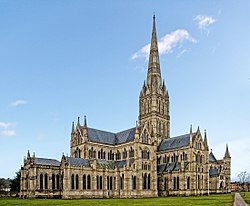Spire


A spire is a tapering conical or pyramidal structure on the top of a building, particularly a church tower. Etymologically, the word comes from the Old English word spir, meaning a sprout, shoot, or stalk of grass.[1]
Symbolically, spires have two effects. One is to show strength and power. A spire, with its spear point, gives the impression of strength. The other is to reach up toward the skies as a religious gesture.[2] This is one reason for its association with religious buildings, and a similar reason has been given for the large pyramids in Egypt and early American civilisations. However, the tallest spires today are secular places of business or hotels, such as The Shard.
As an architectural ornament, spires are most often found on Christian churches.
Spire Media
Before the Burj Khalifa, the Taipei 101 had the former tallest spire in the world.
The Chrysler Building was the world-first skyscraper with a spire
Spire of Salisbury Cathedral (completed 1320) (404 feet (123 metres), with tower and spire)
Chartres Cathedral. The Flamboyant Gothic North Tower (finished 1513) (left) and older South Tower (1144–1150) (right)
Crown spire on the High Kirk, Edinburgh.
The flèche of Rouen Cathedral (centre), (151 meters), the tallest flèche in France
The octagonal tower of Burgos Cathedral (1221–1260), with an array of pinnacles
The tower of Cathedral of Saint Peter of Alcantara in Petrópolis, Brazil with its spire lit up in blue
The spire of Burghley House (1555–1587) is an example of a spire on non-religious building.
References
- ↑ "Online Etymology Dictionary". Etymonline.com. Retrieved 2012-09-09.
- ↑ Robert Odell Bork 2003. Great spires: skyscrapers of the New Jerusalem, 2003.









